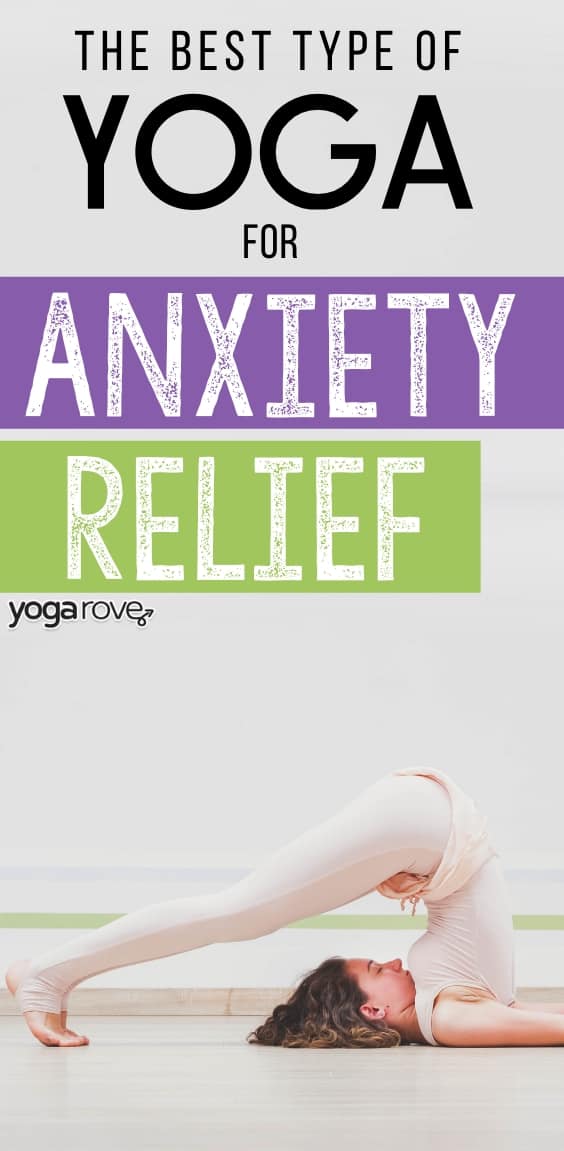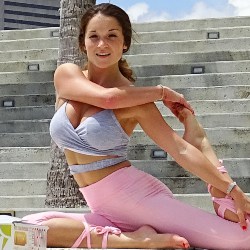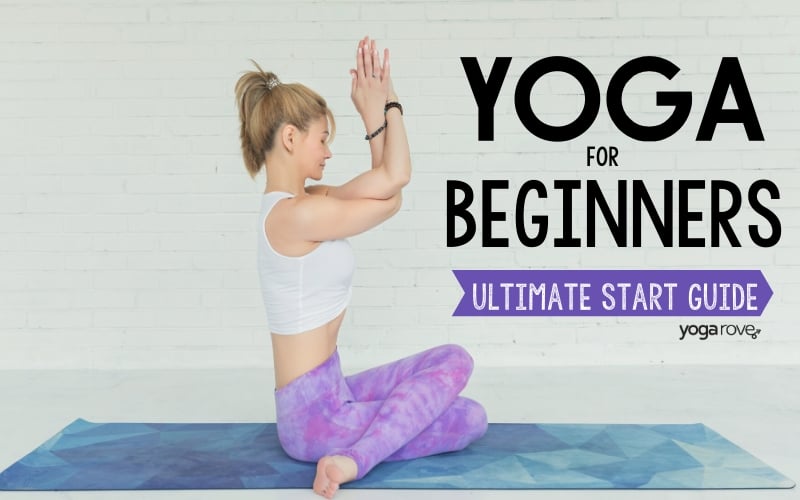This post may contain affiliate links. Please read our disclosure for more info.
Yoga has gained a lot of hype over the years for its benefits, especially relating to stress relief and anxiety ease. But is there a lot of people who wonder if there is a specific type of yoga they should practice to receive the best results.

What Type of Yoga is Best for Anxiety? The short answer- any type. The long answer is it depends on your general preference, and what makes you feel most comfortable. The two most common classes recommended for anxiety are Vinyasa Flow (sometimes offered as Hatha Flow) and Restorative Yoga (sometimes offered as Gentle Yoga or Yin Yoga).
Yoga is well known for its benefits to help calm the body and mind, but some types of yoga may be better than others depending on certain individual factors. Read on to figure out which type of yoga is best for you.
How Does Yoga Relieve Anxiety?
As soon as you step onto your mat, you have entered a safe space. You are encouraged to leave any problems off the mat, and use your time in class to focus solely on the exercises at hand.
The purpose of the physical practice of yoga (often referred to as asana) is to establish a moving meditation. In yoga, the goal is to direct your attention solely to the quality of your breath as you move through the physical postures.
In focusing on where your body is in space and the quality of breath, you are essentially distracting yourself from the mental chatter that can cause anxiety.
While you are physically tuning into your mind-body awareness through asana, yoga also pulls you to the current moment in time. On your mat, nothing matters except for the single moment you are in. Emphasis on the here and now is a reminder to not dwell on the past or future, as the now is the only thing you have control over.
Will Yoga Really Help My Anxiety?
No matter what type of yoga you settle on taking, as long as you are comfortable, you’ll benefit by consistent practice of bringing yourself to the present moment. Yoga allows you to sit with what you’re given; to “lean in” (as Pema Chodron would say) to what you’re feeling; to understand, and thus let it go.
By facing your anxieties, worries, and fears in the face in a calm state of mind on your yoga mat, you are able to see that those big scary monsters are really just shadows in the darkness of things that are much smaller in the light. Your yoga practice is the light that sheds truth on this matter – all you have to do is get on your mat!
“Don’t resist the pain; surrender to it, witness it, allow it, embrace it, and it will be transmuted into peace” – Eckhart Tolle
If you don’t believe me, here’s scientific proof.
Catherine Woodward’s (University of Mississippi) study proved that regular yoga practice enhances not only benefits the practitioner physically by improving muscular strength and body flexibility, improve respiratory and cardiovascular function, but also has multiple mental benefits as well .
The study shows an improvement in recovery from and treatment of addiction, reduction in stress, anxiety, depression, and chronic pain, improvement in sleep patterns, and enhancement of overall well-being and quality of life.
What Type of Yoga Should I Practice to Ease Anxiety?
As spoken earlier, yoga in general has been proven to help relieve anxiety symptoms, but there are a few different practices that may be more beneficial to individuals depending on a few factors.
1. Flow Classes
If you’re just starting to practice yoga, I recommend a Vinyasa or “Hatha Flow” class – these classes combine movement intended to link to cycles of the breath. Your focus of the class will be to time the movements with the breath (for example – you will inhale to enter a pose, and exhale as you exit).
Though a flow class may be considered more difficult physically, I find it to be much easier mentally for when you are having difficulty worrying about things, because you literally don’t have the time to focus on worrying about anything, as you’re too busy following the instruction of the physical flow.
If you’re a beginner or want to take it easy for your first flow class, check your yoga schedule for a Hatha Flow – these classes are still based on physical effort and breath work, but usually the poses and sequences are closer to a beginner level.
2. Restorative
Gentle Yoga, or Restorative Yoga eases the body into positions where the muscles can release tension themselves, while breath work slows the heart rate and declutters the headspace. This is a highly relaxing class that many students will literally say they felt like they had a massage when the class is over.
By relaxing into postures that put the body at ease, the mind is put at ease, and a sense of calm is restored to the body. Do not expect to exert considerable effort in a gentle yoga class!
Though restorative yoga is extremely calming to the physical body, many people with high stress and anxiety tend to have severe difficulty genuinely relaxing in these classes because, quite frankly, there’s just a lot of time to think!
While yoga is the practice of forming union with body and mind to reach a state of calm, it’s not easy to reach if you’re not capable of reigning your focus in enough to achieve that union. If you have never taken a restorative or gentle yoga class before, be mindful of what to expect.
If you are the kind of person who finds slow paced classes such as Pilates or other mat classes to be “boring,” opt for the flow classes instead of the gentle classes. There is no use forcing yourself to sit through a class that you don’t enjoy simply because it works for other people!
To get an idea of what a restorative class is like, check out this simple restorative sequence you can do at home.
3. Bikram Yoga
Think of Bikram like the Crossfit of yoga – it’s physically strenuous, and it’s done in a heated studio.
This yoga is perfect for people who may get anxiety just from the thought of having to practice something new, because it is the same 26 poses repeated in the same cycle in every class you ever take.
Yes, if you take Bikram in New York and are visiting California, if you find a Bikram studio, it will be the exact same class. This feature offers a lot of comfort to yogis who like a regimen. With practice, the sequence becomes something you can do without thinking, and therefore can focus entirely on your breath.
4. Aerial Yoga
Have you ever seen a Cirque de Soleil show where the acrobats glide down gorgeous silks? You can (kind of) do that too! Aerial yoga has become more popular (and more available) throughout many studios in the US, and it’s a wonderful experience.
Aerial yoga classes use yoga silks to assist you into postures that you otherwise would not usually be able to get into, and there is a pretty decent amount of inversions where you don’t actually have to use your physical strength to get upside down.
Inversions help move your lymph fluid through the body and also activate your parasympathetic nervous system (basically the part of the nervous system that turns off the stress response), but because regular inversions require a lot of strength, many people do not reap the benefits of practicing them.
The support the silks offer you in an aerial yoga class allows you to move deeper into postures you wouldn’t normally be able to, and affords you the ability to learn some fun tricks.
Don’t be scared – aerial yoga classes (unless they say advanced) are almost always full of beginners, and the classes are safe for anyone of all ages, as long as you don’t get dizzy easily. You’ll be so busy amazed at how wonderful you feel (and how much fun you’re having!) that you won’t have the time to focus on your anxiety!
Tips for Getting the Most Out of Your Yoga Practice
- Comfort is King. You could be taking the best yoga class with the best teacher in the entire world, but if you aren’t physically comfortable, you’ll be miserable the whole class. Make sure you are wearing clothes that will not slip down when you bend over or ride up in uncomfortable areas. Ladies, make sure that whatever top you are wearing covers your chest decently; low cut sports bras tend to find their way downwards, and you’ll be adjusting yourself constantly.
- Ignore the trends. leave those super cool leather-looking leggings for running errands – if they’re not soft and you’ll be adjusting yourself the whole time, the outfit truly isn’t worth it. Honestly, one of my favorite things to wear to yoga are soft loose sweatpants and a full-coverage sports bra.
- Make sure you have water and a towel if it’s a hot yoga class. If you’re dehydrated, all you’ll think about all class is needing water. If you’re sweating like crazy, all you’ll think about during class is how much your sweat is stinging your eyes.
- Don’t worry about what others think (because they’re too busy worrying about themselves). If a pose is uncomfortable, do whatever you need to do to make it comfortable, whether it’s using a block, a strap, or simply resting in child’s pose.
Too anxious to go to a yoga class in person?
That is completely okay. There are TONS of ways to practice yoga at home, and you can build a very fulfilling practice doing so, whether you ever decide to go to a studio or not.
We created our Free Resource Library because we know it’s possible to achieve your goals, whether they are physical or mental goals, at home.
There are tons of routines you can print out in our library, so if you don’t already have the password, sign up to get it emailed to you here.
You can also check out a few of our other posts to help you get started:
- 5 Minute Beginner Yoga Routine for Stress Relief
- 5 Minute Yoga Routine To Help You Fall Asleep
- How to Start a Home Yoga Practice as a Beginner
- 100 Yoga Quotes for Inspiration and Motivation (with images)
- The One Minute Stress Relief Meditation for Beginners
Previously a dancer, Ashley has been practicing yoga for over 15 years and teaching for 5.
She balances an executive-level “corporate” position during the day with healthy, mindful wellness practices in her free time to stay grounded; she lives on celery juice and cold brew, and can’t live without her dark chocolate!






